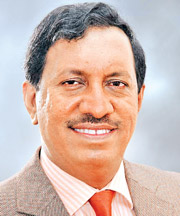New CEA regulations to check vehicle noise pollution
By L.S. Ananda WEDAARACHCHI
 |
 |
| Anura Priyadarshana Yapa |
Charitha Herath |
The Ministry of Environment will introduce regulations soon to
control vehicle noise pollution specially of horns said Central
Environment Authority (CEA) chairman, Charitha Herath in an interview
with the Sunday Observer.
Excerpts of the interview:
Q: What are the noises which disturb the environment.
A: Three noise categories have been identified.
Q: Has the CEA taken any action against this?
A: The CEA under Act No. 47 of 1980 introduced rules and
regulations to control industrial noise and community noise. Rules and
regulations for industrial noise were strictly adhered to during the
past. The CEA clearance was granted only for the industries which were
free from industrial noises.
Q: Can you elaborate on the rules which you will introduce to
control vehicle horn noise?
A: At present most vehicle drivers, specially bus drivers,
sound the horn with no concern towards the people or the environment.
Some private bus drivers deliberately sound the horn to outflank rivals
and take their turn.
No person shall use or cause to sound vehicle horns beyond the limits
under noise control regulations.
Q: How are sound limits measured?
A: The equipment is there and also world accepted Sound
Standards. Noise levels will be measured in terms of the sound pressure
level SPL (Lamax) in decibels (dB) by using sound level metres
conforming to Type One (1) of the British Standards (BS) measuring
equipment as recommended by the CEA
Q: Are these limitations applied to all vehicles whether
stationary or moving?
A: No, these regulations shall not apply to vehicles used to
convey emergency information to the general public during emergency or
disasters. Ambulances, trains, fire brigade vehicles, police vehicles,
and vehicles used by armed forces are also exempted.
Q: Can you quantify environmental noises.
|

SLTB and private buses compete for passengers. |
A: Environmental noises can be quantified in different terms,
the frequency of the sound, the overall sound pressure levels and the
variation of these levels with time. Sound pressure is the basic
measurement of the variations of air pressure that make up sound.
Q: Could noise damage the human ear?
A: The human ear can respond only to the sounds of waves
within the frequency (vibration/second) range of 20" - 2000 Hz usually
the frequency range of our speech is between 100th 6000 Hz. It is
axiomatic that the noise has become a major environmental polluter
around the world.
Q: Who are the major noise polluters in Sri Lanka?
A: The major noise pollution in our country occurs around
commercial locations, mobile noise makers, public address systems,
household activities and entertainment events. A recent survey has
identified motor vehicles as the leading noise polluter in Sri Lanka.
According to the survey the noise mainly emits from vehicle engines and
silencers, particularly of buses and lorries.
Some vehicle owners deliberately replace the factory fitted vehicle
horns with louder air horns and also change the silencers to enhance the
vehicle noise.
Q: What are internationally accepted vehicle horn noise?
A: The internationally accepted maximum level for a vehicle
horn noise is 105 dB whereas in Sri Lanka it is evident that this value
exceeds beyond 115 dB. The sudden shock caused by the vehicle horns may
even lead to road accidents.
Q: The Industrial Technology Institute (ITI) conducted a
survey on the noise emanated from radios and cassette players in
outstation buses on a request by the National Transport Commission. What
was the outcome of that survey?
A: According to ITI, the main objective of that survey was two
fold to evaluate the existing noise levels in buses and to evaluate the
noise perception by the bus commuters.
The survey has revealed that the drivers and conductors responsible
for introducing the noise are continually exposed to noise levels and
face a very big risk of hearing impairment than the passengers
themselves.
Q: Can you elaborate on the effect of noise on human health?
A: Noise causes many types of adverse health effects.
The most prevalent irreversible occupational hazard worldwide is
noise - induced hearing impairment according to the WHO.
The main social consequence of hearing impairment is inability to
understand speech in day-to-day life.
Noise interference with speech comprehension results in a large
number of personal disabilities handicaps and behavioural changes such
as problems in concentration fatigue, irritation decreased working
capacity and a number of stress reactions.
Children living in noisy areas such as close to airports, industrial
complexes and noisy streets are a proof to show that noise effects human
physiological functions, according to the WHO.
Acute noise exposure also causes temporary changes such as increased
blood pressure and heart beating. Susceptible individuals may suffer
permanent effects such as hypertension and ischemic heart diseases as a
result of prolonged exposure. |

